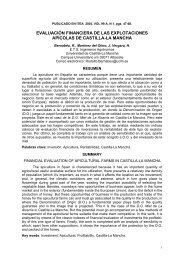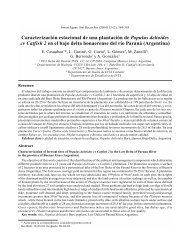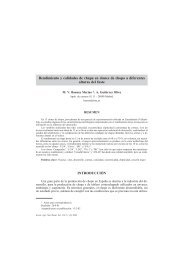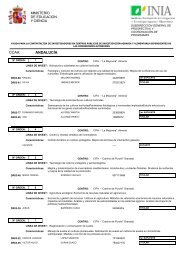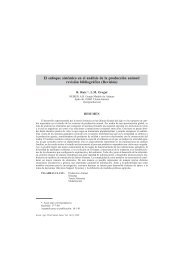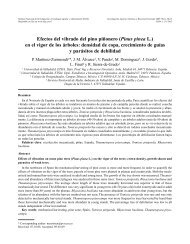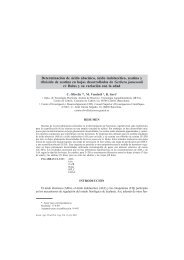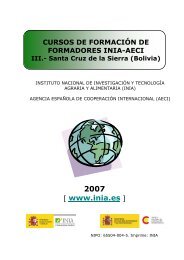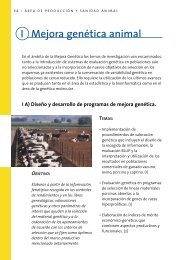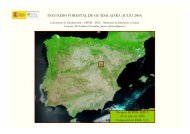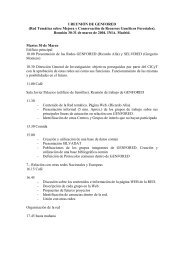Status of medicinal and aromatic plants in - Inia
Status of medicinal and aromatic plants in - Inia
Status of medicinal and aromatic plants in - Inia
Create successful ePaper yourself
Turn your PDF publications into a flip-book with our unique Google optimized e-Paper software.
PRESENTED PAPERS 59<br />
Table 1.Some examples <strong>of</strong> the MAP collection at Newe-Ya'ar <strong>and</strong> <strong>in</strong> situ <strong>in</strong> Israel<br />
No. <strong>of</strong> accessions<br />
Species In situ Ex situ Seed collection<br />
Coridothymus capitatus 14 21 35<br />
Foeniculum vulgare 17 5 25<br />
Melissa <strong>of</strong>fic<strong>in</strong>alis 19 11 28<br />
Mentha sp. 25 17 9<br />
Micromeria fruticosa 17 17 22<br />
Origanum sp. 18 97 115<br />
Marjoram hortensis - 15 35<br />
Rosmar<strong>in</strong>us <strong>of</strong>fic<strong>in</strong>alis - 48 10<br />
Salvia <strong>of</strong>fic<strong>in</strong>alis - 78 96<br />
Salvia fruticosa 15 6 32<br />
Satureja thymbra 12 28 37<br />
Thymus vulgaris - 141 75<br />
Achillea fragrantissima 12 8 15<br />
Achillea sp. 14 15 12<br />
Artemisia sp. 34 77 30<br />
Total 197 584 576<br />
National competitive budgets received annually from the MOS <strong>and</strong> the MOA are applied<br />
to specific species by the IGB. For example national surveys have been conducted, cover<strong>in</strong>g<br />
Foeniculum vulgare, Micromeria futicosa, Satureja thymbra <strong>and</strong> other wild species.<br />
For each species, after herbarium specimens had been studied <strong>and</strong> documentation<br />
prepared, physical searches were conducted <strong>in</strong> order to locate the largest wild populations<br />
cover<strong>in</strong>g the full range <strong>of</strong> variation, with primary attention to geographic <strong>and</strong> climatic<br />
variation (ecotypes). Then, from each <strong>of</strong> the populations that were selected, all<br />
morphological, phenological <strong>and</strong> chemical <strong>in</strong>formation was collected. Some <strong>of</strong> the <strong>plants</strong><br />
were transferred to Newe-Ya'ar, ma<strong>in</strong>ly as cutt<strong>in</strong>gs but sometimes by remov<strong>in</strong>g the whole<br />
plant. The ex situ <strong>plants</strong> are compared with the <strong>in</strong> situ <strong>plants</strong> that grow <strong>in</strong> the wild, with<br />
respect to all the <strong>in</strong>formation mentioned above. Seeds were collected from the <strong>in</strong> situ <strong>and</strong><br />
from the ex situ <strong>plants</strong> for at least two successive years.<br />
Thus, from the liv<strong>in</strong>g collections, as well as from <strong>in</strong> situ sites, we have obta<strong>in</strong>ed <strong>and</strong> hold<br />
data on morphological characters, flower<strong>in</strong>g behaviour, harvest recovery <strong>and</strong> essential oil<br />
content <strong>and</strong> composition. This <strong>in</strong>formation is unique <strong>and</strong> helps us <strong>in</strong> our selection<br />
programme, <strong>in</strong> cooperation with other scientists, <strong>and</strong> as a l<strong>in</strong>k to the <strong>in</strong>dustry. The reports<br />
that are submitted to the IGB are <strong>in</strong> the public doma<strong>in</strong>.<br />
MAP production<br />
Israel produces MAPs on a commercial scale, <strong>in</strong>clud<strong>in</strong>g the various products listed <strong>in</strong><br />
Table 2. Each group <strong>of</strong> products <strong>in</strong>volves a great number <strong>of</strong> species <strong>and</strong> varieties. For<br />
example, we grow more than 42 species for fresh herb production (about 100 varieties) <strong>and</strong><br />
more than 30 species for ornamental purposes (more than 80 varieties). Some <strong>of</strong> the varieties<br />
that are used commercially are cultivars but some are unregistered varieties that were<br />
brought, by us, directly from the wild.<br />
Collection from wild populations (from more than 200 acres) <strong>in</strong>cludes a great number <strong>of</strong><br />
species. The specific species that are collected depend on the orig<strong>in</strong> <strong>and</strong> the diet <strong>of</strong> the<br />
collectors.<br />
There is a small <strong>in</strong>dustry <strong>in</strong> Israel that distils or extracts secondary metabolites from<br />
MAPs grow<strong>in</strong>g <strong>in</strong> the country, but most <strong>of</strong> their raw material is imported.<br />
If we exclude herbs (<strong>plants</strong> conta<strong>in</strong><strong>in</strong>g essential oils) that are used also for <strong>medic<strong>in</strong>al</strong><br />
purposes, the "true" <strong>medic<strong>in</strong>al</strong> <strong>plants</strong> that are grown commercially are very limited, grown<br />
by a few farmers for local use.




